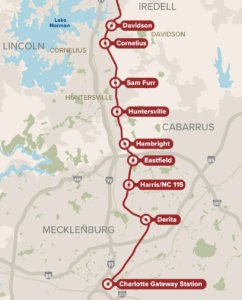Oct. 17. [Analysis] By Kurt Naas. The Red Line commuter rail from Charlotte to Mooresville is back in the news again. Norfolk Southern has finally agreed to negotiate the sale of their tracks, Charlotte Area Transportation System (CATS) is kicking off a series of town halls, and Charlotte is proposing a county-wide sales tax increase of 1 percent to pay for it.
All of the Lake Norman towns as well as the Charlotte and Mecklenburg County boards have voted in favor of it. Despite the excitement (or maybe because of it), nobody seems to be asking the tough questions. Perhaps we should start.

Red Line with 10 stops
Some background:
Taxing authority can only be granted by the state legislature, so local support is essential. If the legislature grants authority the issue will be put on the ballot as a county referendum, most likely in 2025. Legislation has already been drafted and it stipulates half of the tax receipts must go toward road improvements and the other half to public transportation.
The first issue is how the money gets distributed. For the road funding portion, instead of pooling the money and ranking projects county-wide, the proposed legislation balkanizes tax receipts among the towns based on their percentage of town-owned roads. Conveniently Charlotte will get 80 percent of the receipts designated for roads, or over $100 million per year.
Cornelius, meanwhile, will get a mere 2 percent. That’s a little over $5 million for roads with the same amount allocated to Red Line construction. It’s a pittance compared to Charlotte but if we were to raise the same amount through property taxes, it would amount to a 56 percent property tax increase! That’s a pretty hefty levy for a marginal gain but remember only half of the receipts got to roads.
Even if funds were pooled and allocated based on a ranking system, the legislation forecloses on Lake Norman having a fair shot at obtaining needed funding. Current road funding in Lake Norman is an afterthought because funding priorities are determined by the all-important Charlotte Regional Transportation Organization (CRTPO). Charlotte’s single delegate wields 42 percent of the vote, making what should be a regional planning body a de facto dictatorship.
As a condition of supporting the legislation the town board should have insisted we fix this. It’s impossible without Charlotte’s acquiescence, and the sales tax legislation is about the only thing on which Cornelius will ever have any political leverage over Charlotte. Instead the towns made it worse: the new legislation will create a new regional planning body to replace CATS, and Charlotte will get 45 percent of the vote!
What’s the cost?
Then there’s the issue of cost. Ominously, there is no current cost estimate for the Red Line. The most recent proxy is the Blue Line extension, a nine-mile route completed in 2018 at a cost $1.2 billion. The proposed Red Line is 23 miles long. Construction costs could easily run upwards of $2 billion if not more. That’s not pessimism, it’s history: Under CATS management, public transportation ridership is half of its 2010 peak, yet CATS’ budget has doubled. This is not sound operational management, yet you are being asked to pay and trust CATS will manage this mega-project on budget and schedule.
Do the math
Another issue is the viability of the Red Line as a transportation solution. Basic arithmetic shows this is an iffy proposition: Each day about 100,000 vehicles crawl through Lake Norman on I-77. So, for even half the utility of I-77 the Red Line would have to carry 50,000 trips per day, or 25,000 round trips. That averages out to 5,000 people per Lake Norman stop! Where will these commuters park?
Back in 2012 ridership estimates were so low the Red Line did not qualify for federal funding. The fact that there are no ridership estimates available today is concerning. Any mention of revenues from fare-paying passengers is conspicuously absent in public literature
And remember, that’s just half the utility of I-77—for $2 billion.
From a commuter’s perspective the Red Line is equally dubious: A one-way trip takes about 45 minutes, and trains will run every 30 minutes during rush hour. So the commute time will be the drive time to the station + wait time for train + travel time to downtown gateway + travel time to final destination. Miss the train and it sets you back another 30 minutes. What’s more likely is commuters will do the math and quickly figure out that, despite traffic hassles and private toll lanes, it’s still quicker on average to slog down I-77.
Granted the travel time should be more reliable, but we already have a “reliable travel time” solution with the private toll lanes (which we’ll be paying for until 2068).
No sunset provision
Also unsettling is what the legislation does not contain: A sunset provision. The sales tax will stay on the books until it is repealed by a county-wide vote. For all practical purposes, we are stuck with this tax forever.
Perhaps what’s driving this is the promise of high-density development along the route similar to what happened with the Blue Line in South End. But do we really want high-rise apartments in Cornelius? Do we really need to give developers additional incentive to build?

NAAS
With no cost or ridership estimates we’re being asked to commit to a new eternal tax to fund a multi-billion project managed by an entity with a poor track record.
The Red Line project needs to be placed on a siding until we get some answers.
—Kurt Naas
Naas is a former member of the Cornelius Board of Commissioners and the founder of WidenI-77, a grassroots effort that opposed private toll lanes on I-77.



